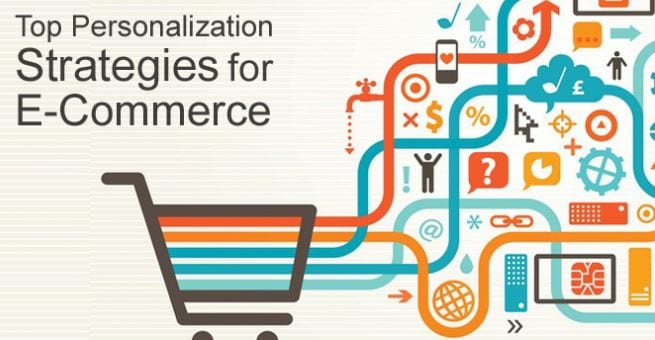Anyone who is active in marketing or Ecommerce endorses the importance of personalization of the customer experience. But that does not mean that everyone succeeds in the mission. Personalization in Ecommerce is especially complicated. After all, that's what we're talking about website- or webshop personalization. And in part that is a technical story. The right personalization tools will help you run the operational side of that story. But there is more to it. We list 10 important success factors.
1. Personalization in Ecommerce starts with a strategy
Dynamic content, loyalty programs, personalized email campaigns. Personalization Ecommerce has many faces and techniques. But where do you start? How is your webshop or B2B platform currently performing and what does your target group really find important? Start measuring and analyzing. From there, formulate a personalization strategy, set priorities, and proceed step by step. Choose the personalization tools that demonstrably support your strategy.
2. No personalization in Ecommerce without insight and data
Every form of personalization is based on one core condition: know your customers. Know what they want, map out their search and buying behavior permanently, develop personas and continue to collect and analyze information. Does your current platform offer insufficient tools for that? Then look at the possibilities of a Customer Data Platform (CDP). Because data is key in personalization in Ecommerce.
3. Embrace new technology and AI
Website or shop personalization is complicated. Especially if your platform generates a lot of traffic, records high search volumes and serves a diverse target group, smart and robust automation is crucial. New technologies offer new opportunities. Follow the developments (or let them follow and get advice) and see which personalization tools add value to your strategy. Dare to experiment with Artificial Intelligence and machine learning software.
4. Build in privacy guarantees and communicate them to your customers
Online consumers and business relations indicate in all kinds of surveys that they value a personalized user experience. In fact, the generation that grew up with the Internet and Ecommerce expects no different. At the same time, privacy and the way in which you deal with customer data remain sensitive themes. Make sure that your customer environment is privacy-proof and tell your customers how you deal with both privacy legislation and their personal data. Personalization in Ecommerce is only tenable if the privacy rules are observed. Good GDPR proof CDP system (Customer Data Platform) is ideal for this.
5. Learn from your colleagues and competitors
Major platforms such as Amazon, bol.com, booking.com, etc., have been successfully using advanced personalization techniques for years. Both onsite and with additional marketing and sales campaigns. Immerse yourself in the best practices and translate what you see happening into your own personalization strategy. Then research which (combination of) tools best support your strategy and dare to test it. Opt for gradual implementation.
6. Start segmenting your customer base
Use patterns that are visible through customer data for segmenting your customer and relationship files. This can be done on the basis of the interest shown in specific product categories (search behavior), concrete transactions (purchasing behavior), personal characteristics and geographical characteristics. You can then use segmentation tools on the basis of which your customers / visitors are recognized via cookies or login and are offered appropriate content.
7. Personalized recommendations ensure conversion
Segmentation is an important step in the right direction. But you can go one step further by offering each customer a unique experience. You do this with the so-called recommendation tools. These recognize visitors automatically and in real time. This allows you to refine customer segments and ultimately even offer one-to-one content by offering products, services and information that are fully tailored to the interests and preferences of the customer. Such personalized recommendations stimulate both retention and conversion. And that's the bottom line of personalization in Ecommerce.
8. Apply personalization in Ecommerce across the entire sales funnel
Today's customer journey has many channels, stages, emotions and facets. Consumers shop physically and online, compare, read reviews on social media, seek alignment with brand values, embrace mobile phones, are always 'on' and have long taken for granted a multichannel offering. That's why it's important to apply personalization consistently across the entire sales funnel. Keep this in mind when selecting personalization tools.
9. Aim for the automation of dynamic content
With static web pages you no longer win the battle for the consumer. Dynamic content is the future. That means: personalized landing pages based on location, time, language and even the weather. Dynamic content does not only work for your webshop or website, but also, for example, for receipt or confirmation messages via email or messaging. The more visitors and customers you serve, the more complicated this is. Therefore, bet high when automating dynamic content.
10. Avoid personal blunders
Personalization in Ecommerce is a must to continue to meet high customer expectations. The ultimate customer journey in the entire sales funnel exists by the grace of relevant content tailored to customer segments or individual customers. But do it right! Because personalization that goes wrong is counterproductive. For example, an excessive use of cross selling based on customer data and real-time search behavior can be quite annoying. With the risk that customers will drop out prematurely. And the salutation 'Dear Sir…' in an email message for a customer of the female sex, or vice versa, is disastrous. Avoid such blunders. The selection of the right personalization tools is a step in the right direction.
PERSO Solutions helps with that selection. First of all, by making the range of personalization tools transparent and accessible. Use it to your advantage. Secondly, PERSO Solutions wants to exchange knowledge and experiences and we have a team ready to help you on your way at your time. We do this professionally and personally.







